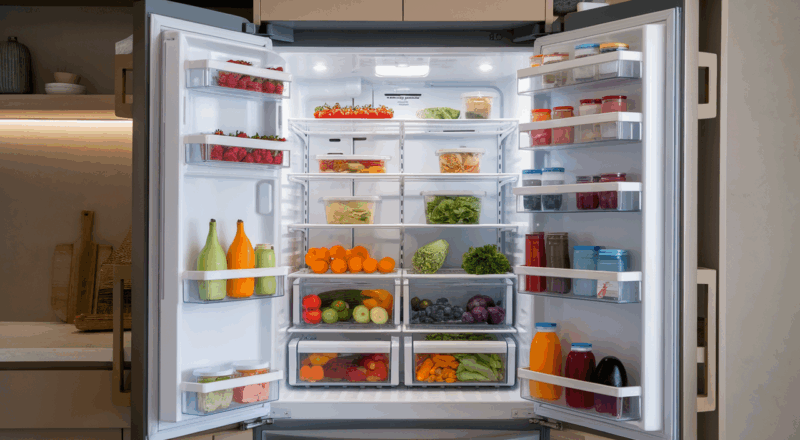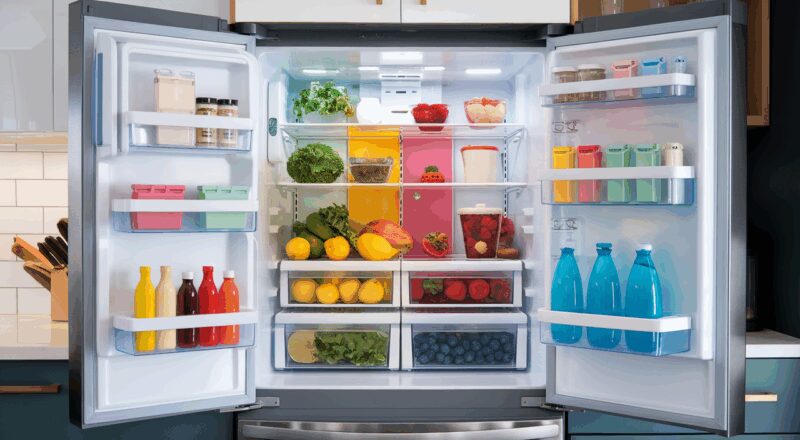The color-coded fridge trend has evolved from a viral social media sensation with 5 billion+ TikTok views into a practical organization method that balances visual appeal with functionality. Netflix’s “The Home Edit” helped popularize this approach with their rainbow organization technique, attracting followers who value both beauty and efficiency in their kitchen storage.
Key Takeaways
- The trend focuses on decanting foods into clear containers and organizing them by color, making inventory tracking easier and potentially reducing the 30–40% food waste typical in American households.
- Essential tools include clear storage containers, matching sets, labels, produce bags, and dividers, with initial setup costs typically ranging from $100–300.
- While visually appealing, the system requires significant time investment for setup and maintenance after each grocery trip.
- Creating dedicated color zones (green for vegetables, red for fruits, etc.) establishes an intuitive system that simplifies meal planning and food accessibility.
- Critics note potential drawbacks including environmental impacts from plastic container purchases and the prioritization of aesthetics over practical functionality.
Benefits of the Color-Coded Fridge System
I’ve found this color organization method creates a visual inventory system that makes food items instantly recognizable, preventing hidden items from spoiling in back corners. By transferring groceries to transparent containers immediately after shopping, I can track everything at a glance and significantly cut down on waste.
Meal Preparation Made Easy
The system works particularly well when I establish specific zones — keeping greens together, grouping colorful fruits, and designating areas for dairy and proteins. This color-guided arrangement speeds up meal preparation since I know exactly where to look for ingredients.
Initial Investment vs. Long-Term Benefits
The initial investment in quality containers pays off through extended food freshness and reduced waste, though the time needed for maintenance presents a legitimate challenge. After each shopping trip, I must wash, prep, and organize everything — a process that takes commitment but delivers satisfying results.
Tips for Getting Started
- Start small by organizing just fruits and vegetables by color.
- Invest in a few versatile, high-quality clear containers first.
- Create labeled zones for specific food colors or types.
- Maintain the system by resetting after each grocery haul.
For anyone considering this approach, I recommend starting small with just fruits and vegetables before expanding to a fully color-organized refrigerator. This gradual transition helps develop sustainable habits without feeling overwhelmed by a complete system overhaul.
Inside The Viral Color-Coded Fridge Movement
The Rise of the Color-Coded Fridge Trend
The color-coded fridge trend has exploded across social media, racking up an impressive 5 billion views on TikTok under #fridgeorganization alone. This isn’t just another fleeting internet fad – it’s revolutionizing how I approach kitchen organization. Netflix’s “The Home Edit” sparked this movement with their signature rainbow method, turning ordinary fridges into Instagram-worthy masterpieces.
With both Instagram’s 1.4 billion users and TikTok’s 1 billion-strong community embracing this style, the color-coded fridge trend has become a legitimate lifestyle choice for many. I’ve noticed how this organizational method does more than just make fridges look pretty – it creates a system that’s both functional and visually appealing, similar to how aesthetic breakfast trays combine practicality with style.
Making Your Fridge a Rainbow Haven
The color-coded fridge trend focuses on transforming your refrigerator into organized zones based on color schemes. Here’s what you’ll need to get started:
- Clear storage containers in various sizes
- Matching container sets for uniformity
- Label maker or waterproof labels
- Produce storage bags
- Container dividers
The key to mastering this trend lies in decanting – transferring items from their original packaging into clear containers. This step helps maintain the visual harmony while extending food freshness. By grouping similar colors together, you’ll create an organized system that makes finding items quick and simple.
Popular social media hashtags like #fridgerestock and #organization showcase thousands of examples of this method in action. The visual appeal of these organized fridges isn’t just for show – it helps track inventory at a glance and reduces food waste by keeping everything visible and accessible.
The color-coded approach transforms routine grocery restocking into an oddly satisfying experience. Each category has its designated spot: greens (lettuce, herbs) in one section, reds (tomatoes, strawberries) in another, creating an intuitive system that’s easy to maintain. This organization method has proven so effective that it’s sparked a wider conversation about kitchen efficiency and food storage practices.
The Real Benefits (and Drawbacks) of Rainbow Refrigerator Organization
Why The Color-Coded Fridge Trend Makes Sense
The color-coded fridge trend isn’t just about creating Instagram-worthy kitchen moments – it’s addressing a serious issue. According to the USDA, Americans waste between 30-40% of their food supply at the consumer level. I’ve found that implementing a strategic organization system can significantly reduce this waste by making food more visible and trackable.
Here’s what makes this trend particularly effective for many households:
- Easier meal planning through visual categorization
- Quick identification of expiring items
- Reduced duplicate purchases
- Less stress during meal prep
- Better portion control
Hidden Costs of the Color-Coded Fridge Trend
While organizing your fridge by color can transform your food storage game, let’s talk about the real investment required. The initial setup typically costs between $100–300+, depending on your container choices and fridge size. Just like those aesthetic breakfast trays that caught everyone’s attention, the color-coded fridge trend requires both financial and time commitments.
The setup process isn’t quick either – you’re looking at several hours for the initial organization, plus regular maintenance after each shopping trip. I’ve noticed these additional considerations that often get overlooked:
- Storage containers can be heavy when full, making them challenging for some users
- Regular cleaning and reorganizing is necessary to maintain the system
- Additional plastic consumption through new container purchases
- Limited accessibility due to cost barriers
- Space constraints in smaller fridges
- Potential food waste if items don’t fit standard container sizes
The color-coded fridge trend also faces criticism for sometimes prioritizing looks over functionality. While those rainbow-arranged shelves look stunning on social media, they might not always align with real-world usage patterns. Some users report spending more time maintaining the aesthetic than actually cooking or meal planning.
The environmental impact deserves attention too. While the system aims to reduce food waste, the initial purchase of multiple plastic containers contributes to plastic consumption. I recommend considering whether existing containers can be repurposed before buying new ones, balancing the visual appeal with practical and environmental considerations.

Essential Tools and Implementation Guide for the Color-Coded Fridge Trend
Must-Have Organization Tools
The color-coded fridge trend has sparked a revolution in kitchen organization, and I’ve found that having the right tools makes all the difference. According to market research, the global home organization industry reached $11.8 billion in 2021, showing just how serious people are about getting organized.
Here are the essential items I recommend for creating your color-coded system:
- iDesign Linus and mDesign bins ($10–20 each) for basic storage
- OXO turntables for easy access to condiments and smaller items
- Stasher bags for sustainable food storage
- Brother P-Touch labels for clear identification
- 8-piece bin sets ($50–70) for complete organization solutions
Setting Up Your Color-Coded Zones
I’ve discovered that implementing the color-coded fridge trend starts with proper planning. Just like creating an aesthetic breakfast tray, the key is in thoughtful organization and visual appeal.
The process works best when you follow these steps:
- Empty your fridge completely
- Clean all surfaces thoroughly
- Sort items by category
- Assign specific color zones for each food group
- Select appropriate containers for each zone
When choosing containers, I recommend considering these options:
- Acrylic containers: Perfect for durability and clear visibility
- Standard plastic: Budget-friendly and lightweight
- Glass containers: Eco-conscious choice with excellent longevity
For optimal organization, I suggest creating dedicated zones with specific colors:
- Green zone: Fresh vegetables and herbs
- Blue zone: Dairy products and eggs
- Red zone: Raw meats and proteins
- Yellow zone: Fruits and citrus
- Clear zone: Drinks and water
The color-coded fridge trend isn’t just about aesthetics — it’s a practical system that helps reduce food waste and makes meal prep easier. By using clear containers and maintaining consistent zones, I’ve found that families can save money by keeping better track of their food inventory and expiration dates.
Organizing your kitchen with a minimalist aesthetic has gained popularity thanks to the viral appeal of fridgescaping on social media.
Sources:
The Washington Post – “Perfectly Organized, Aesthetic Fridge TikTok”
Today – “Home Edit”
Homes & Gardens – “Fridge Organization Ideas”
USDA – “Food Waste FAQs”
Grand View Research – “Home Organization Products Market”







